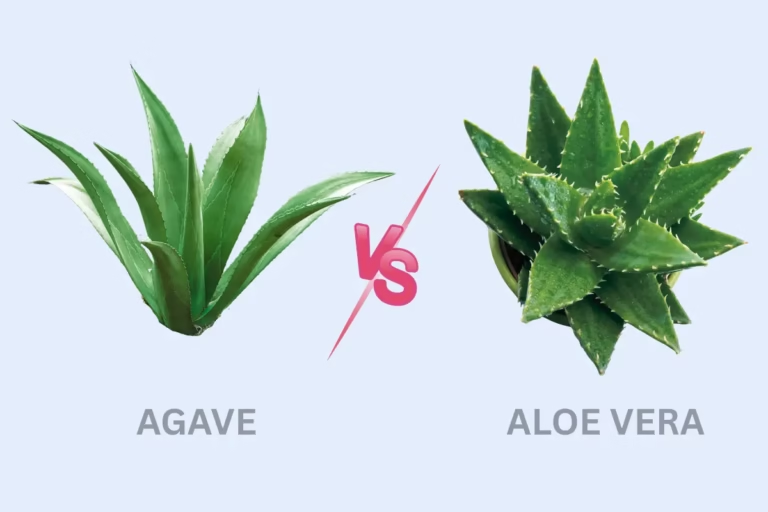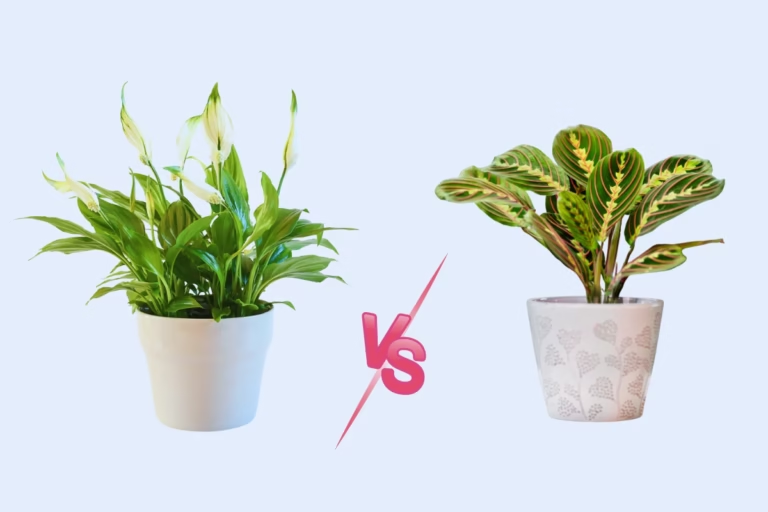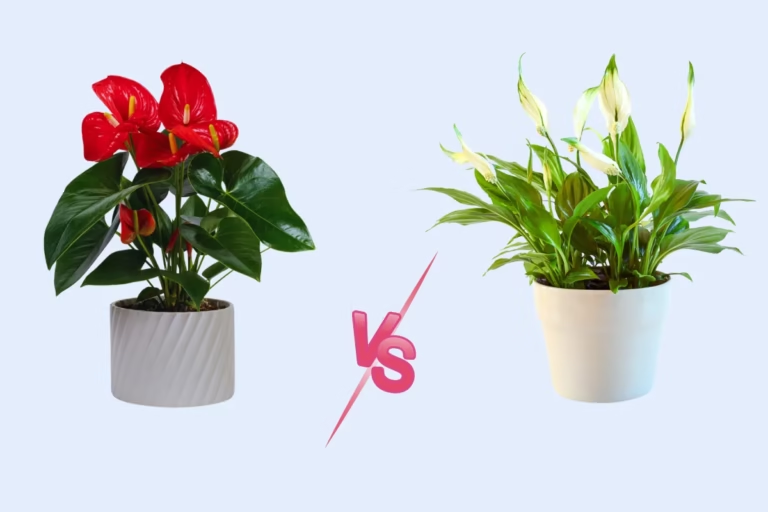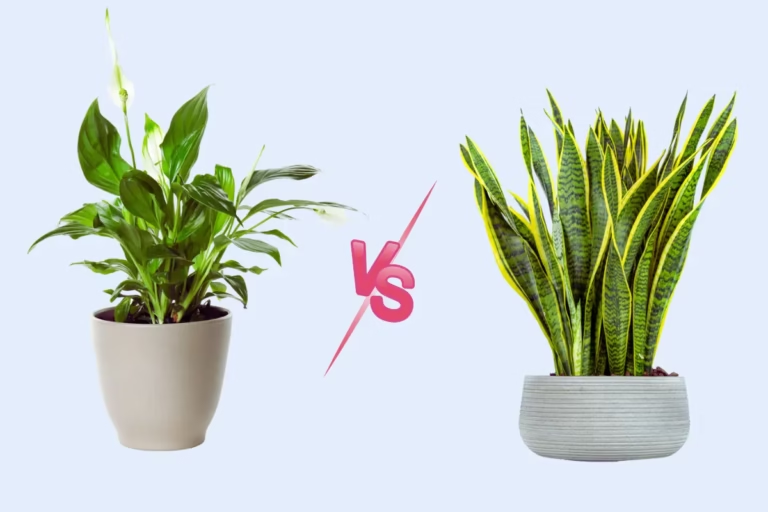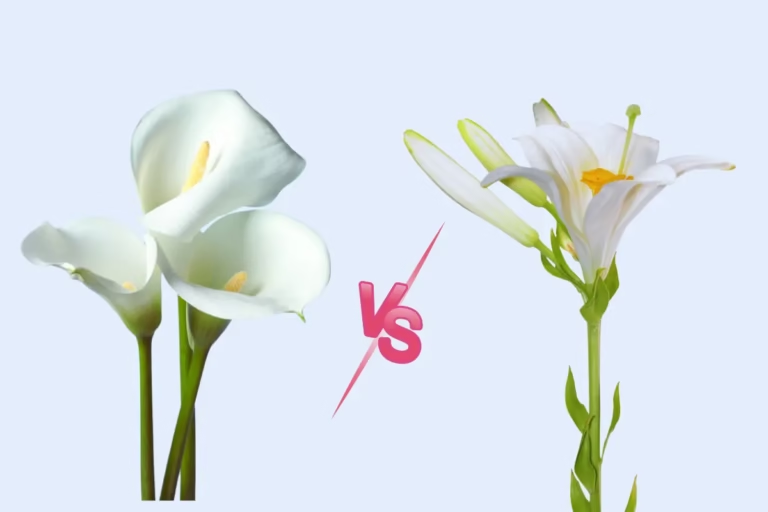Peace Lily Vs. Chinese Evergreen | Different & Similarities

Are you confused about the plant selection between the elegant peace lily and the vibrant Chinese evergreen? Many plant lovers find themselves puzzled by the striking similarities in leaf shape and overall aesthetics of these two beauties. Their lush, glossy leaves and bushy growth habits make it easy to see why they might be mistaken for each other. Whether you’re drawn to the peace lily’s stunning blooms or the colorful patterns of the Chinese evergreen, we’ll ensure you make the perfect choice for your decor!
Quick Answer
Peace Lily: Elegant blooms, weekly water, pet-toxic. Chinese Evergreen: Colorful leaves, monthly water, pet-safe. Both purify air—choose blooms or easy care!
Peace Lily vs. Chinese Evergreen: Ultimate Care Comparison
Feature | Peace Lily (Spathiphyllum) | Chinese Evergreen (Aglaonema) |
|---|---|---|
Scientific Name | Spathiphyllum spp. | Aglaonema spp. |
Origin | Tropical Americas | Southeast Asia |
Appearance | Glossy green leaves + white flowers | Colorful patterned leaves (pink/red/silver) |
Flowers | White spathes (2-3 times/year) | Rare, hidden greenish spathes |
Light | Low to bright indirect | Low to medium indirect |
Water | Keep soil moist (droops when thirsty) | Let soil dry between waterings |
Humidity | Loves high humidity | Tolerates average humidity |
Toxicity | Mildly toxic to pets | Non-toxic (pet-safe) |
Air Purifying | NASA-approved (removes toxins) | Filters VOCs effectively |
Growth Speed | Moderate | Slow to moderate |
Lifespan | 5-10 years | 10-15+ years |
Best For | Beginners, humid spaces, offices | Low-light corners, pet homes |
What is peace lily?
Peace Lily, also know as Spathiphyllum is a low-light champion with glossy leaves and elegant white spathes that bloom 2-3 times yearly. This NASA-approved air purifier thrives in humid spaces (bathrooms perfect!) and droops dramatically when thirsty, making care foolproof. Mildly toxic to pets but ideal for bedrooms/offices. Loves well-draining soil and tolerates neglect—just keep it away from direct sun to avoid leaf scorch. A timeless, adaptive beauty for any home!
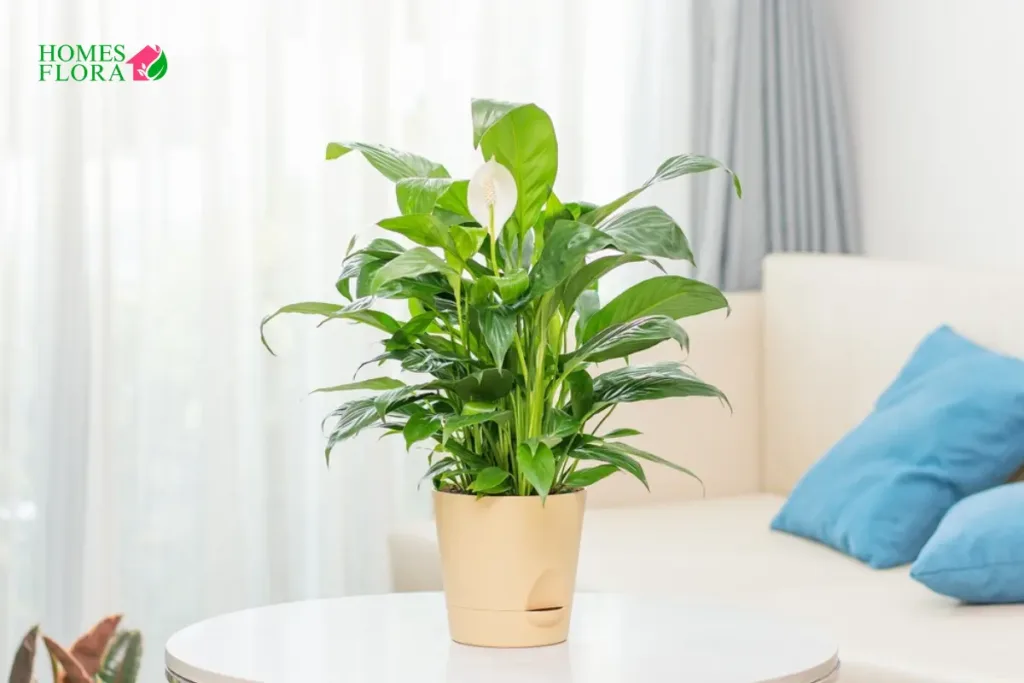
What about Chinese evergreen?
Chinese Evergreen, scientifically known as Aglaonema is your low-light warrior with stunning patterned leaves—think pink, silver, or red streaks! Unlike the flowering Peace Lily, it’s all about foliage, thriving in dim corners where other plants perish. Drought-tolerant and pet-friendly, it purifies air silently while asking for just monthly water when soil dries. Perfect for offices, bedrooms, or forgetful plant parents!
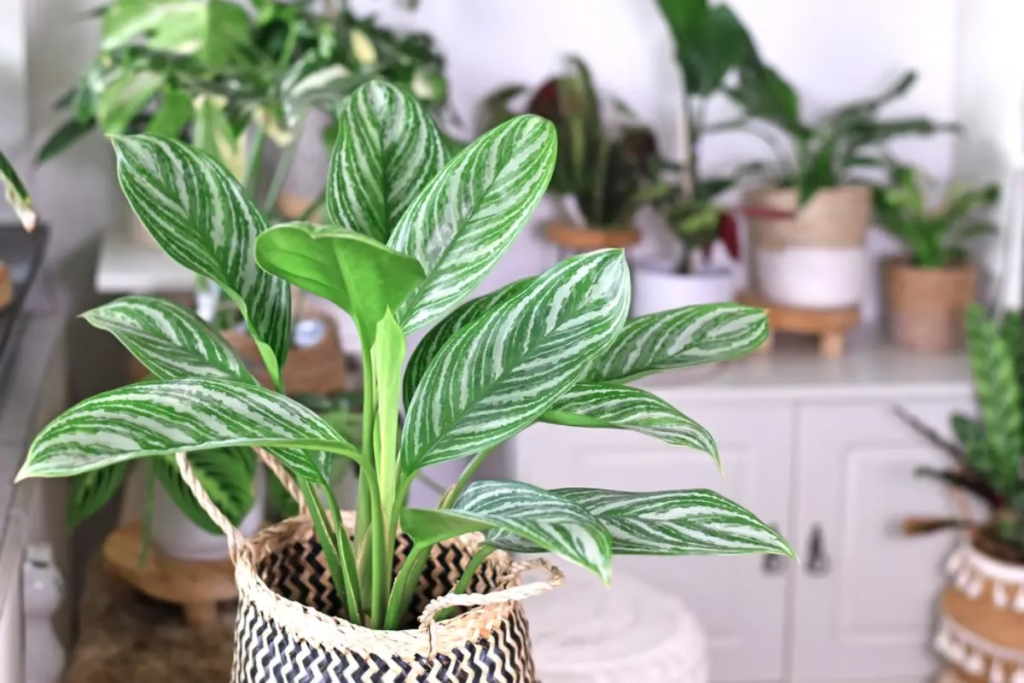
Peace Lily & Chinese Evergreen Flower’s Difference
The Peace Lily’s showy white spathe (a leaf-like bract) wraps a spike-like spadix, blooming 2-3 times yearly as its star feature. In contrast, the Chinese Evergreen’s greenish-white spathe is smaller, often hidden by foliage, and rarely appears indoors—this plant prioritizes colorful leaves over flowers.
Both share the Araceae family’s signature spathe-spadix structure, but the Lily’s blooms are ornamental, while the Evergreen’s are botanical curiosities you’ll likely never see.
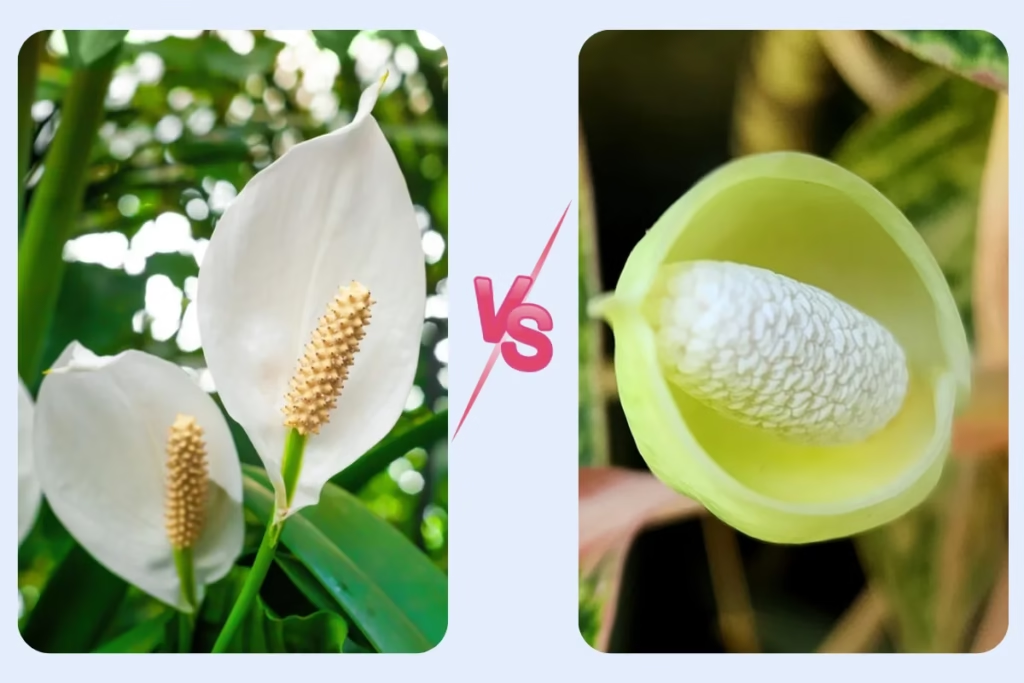
Chinese Evergreen vs. Peace Lily: Key Differences
Appearance
The Peace Lily stands out with its glossy, dark green leaves and white, calla-like flowers, creating a striking contrast while the Chinese Evergreen offers broader leaves with vibrant patterns in silver, red, or pink, depending on the variety.
Light Requirements
The Spathiphyllum thrives in low to moderate indirect light. It can adapt to low light conditions, flourishing best in temperatures between 65-80°F (18-27°C). On the other hand, the Chinese Evergreen enjoys low to medium indirect light and can tolerate fluorescent lighting, making it ideal for office spaces. For optimal growth, it prefers a temperature range of 60-85°F (15-29°C).
Watering Needs
All varities of peace lily demands more frequent watering, often showing visible signs like wilting when it’s thirsty. In contrast, the Chinese Evergreen is more drought-tolerant and prefers its soil to dry out a bit between waterings, making it less high-maintenance.
Humidity Preferences
The Peace Lily prefers a higher humidity level and thrives in more humid environments like kitchens or bathrooms. The Chinese Evergreen is more forgiving, tolerating drier indoor air but enjoying moderate humidity.
Growth Rate and Size
The Peace Lily can reach a height of 2-3 feet and grows at a moderate rate. The Chinese Evergreen grows more slowly and varies in size, typically between 1-3 feet, depending on the variety.
Toxicity
Both plants can be toxic to pets and humans if ingested. For pet owners, understanding is peace lily toxic to cats and dogs can help make informed decisions about plant placement. They may cause irritation or more serious symptoms, so it is essential to keep them out of the reach of curious pets or children.
Air Purification
Known for its superior air-purifying abilities, the Peace Lily excels in removing toxins like benzene and formaldehyde. Although the Chinese Evergreen also purifies air, it is generally considered less effective than its counterpart.
Ease of Care
The Chinese Evergreen is much easier to care for and more forgiving of neglect. It can tolerate a broader range of indoor conditions. While beautiful, the Peace Lily is slightly more finicky due to its higher water and humidity needs. It’s a plant that visibly shows when it needs attention.
Lifespan and Durabilit
The Lifespan of Peace Lily is about 3-5 years with proper care. However, it can live longer in ideal conditions. It’s somewhat sensitive and requires consistent attention to thrive. On the other hand, the Chinese Evergreen is more durable and long-lasting, and it often lives for many years with minimal care. Its resilience to varying conditions makes it a sturdy choice for those seeking a low-maintenance plant.
What is similar in Spathiphyllum and Aglaonema
Indoor Suitability
Both plants are popular choices for indoor environments, as they thrive in low—to medium-light conditions and can adapt to various spaces.
Air Purification
Both plants are known for their air-purifying qualities. They help to remove toxins such as formaldehyde and benzene from the air, improving indoor air quality.
Size
Both plants can grow to similar heights, generally reaching 1-3 feet tall, making them suitable for tabletops or floor displays.
Low-Light Tolerance
Both plants can thrive in low-light conditions, making them ideal for rooms with limited natural sunlight.
Tropical Origins
Peace Lily and Chinese Evergreens are tropical plants, so they prefer warm, humid environments, though they can adapt to typical indoor humidity levels.
Toxicity
Both plants are toxic to pets and humans if ingested, causing irritation or more severe symptoms, so they should be kept out of reach of children and pets.
Easy Care
Both are relatively low-maintenance plants, suitable for beginner plant owners, though the Chinese Evergreen is more forgiving of neglect, while the Peace Lily requires a bit more attention to watering.
These similarities make them both excellent choices for those looking to enhance their indoor environment with attractive, easy-care plants contributing to healthier air quality.
Challenges faced by These indoors plants
Watering Needs
The Peace Lily tends to wilt quickly if it doesn’t get enough water, so it needs regular attention to stay healthy. On the other hand, the Chinese Evergreen can handle drier conditions but is at risk of root rot if overwatered. It’s essential to strike the right balance for both plants, as each has different watering preferences.
Light and Humidity Challenges
While the Peace Lily thrives in low to moderate indirect light, it struggles when the air is too dry, often showing brown leaf tips. Although more flexible with light conditions, the Chinese Evergreen can retain its bright colors if given proper lighting. Both plants require specific care, but the Peace Lily is more delicate regarding humidity and light.
Temperature Sensitivity
Both plants prefer stable, warm indoor conditions. Still, the Peace Lily is especially vulnerable to sudden drafts or cold air, hindering its growth. The Chinese Evergreen is slightly more tolerant but must be kept from cold environments to stay in good shape.
Soil and Root Issues
The soil should remain moist without being soggy for the Peace Lily, as overwatering can lead to root problems. The Chinese Evergreen prefers drier soil between waterings but can also suffer from root rot if it sits in wet soil for too long. Proper soil care is essential for both plants, with the Peace Lily being a bit more sensitive to improper moisture levels.
Which Plant is the Right Choice for You?
When choosing peace Lily
If you’re looking for a striking plant with lovely white flowers and excellent air-purifying qualities, the benefits of peace lily make it a great option. It’s perfect for brightening up spaces like kitchens or bathrooms, especially if you can provide the humidity and care it needs.
When choosing Chinese Evergreen
On the other hand, if you prefer a low-maintenance plant that can thrive in various lighting conditions, the Chinese Evergreen is an ideal choice. Its colourful foliage adds character to any room and is more forgiving if you occasionally forget to water it. Similarly, other popular indoor plants, like the money tree vs umbrella tree, also offer unique features, making it easier to find the perfect plant for your space.
Why compare indoor Plants?
Choosing the right houseplant can be tricky, especially when so many options look equally stunning! That’s why I’ve compared the Peace Lily to some of the most popular plants out there. Whether you’re looking for low-maintenance greenery, tropical vibes, or colorful blooms, these comparisons will help you make the best choice for your space.
Final Thoughts
Lastly, this blog has cleared up any confusion you had about the differences and similarities between the Chinese Evergreen and the Peace Lily. With a better understanding of their unique qualities, you can confidently choose the plant that best fits your lifestyle. Whether you’re captivated by the Peace Lily’s elegant blooms or the colorful leaves of the Chinese Evergreen, either option will brighten your space and improve your indoor air quality. Happy planting, and may your home flourish with greenery!

